A few weeks ago, when I reviewed Eachine’s first AIO FPV camera, I was surprised by its small size. Now they did it again, the Eachine TX01 and TX02 are even smaller. These two new FPV cameras are specially designed for small brushed drones. Through the TX01 FPV camera, it seems that finally Eachine managed to offer a direct competitor for the popular FX797T camera and only for about half of its price.
If the Eachine MC02 with its 9g proved to be too heavy to be installed on my Eachine E010, I think the TX01, having only 4.5g, will be just perfect for turning the E010 Mini into a Tiny Whoop.
Apparently, the only difference between the TX01 and TX02 is the output power. While the TX01 has 25 mW, the TX02 has 200 mW. This should not fool you, theoretically, 200 mW should give you only about twice the range compared to the 25 mW. In my opinion, indoor flight and proximity park flying will be just perfect for the Eachine TX01. It is also a bit lighter and consumes less power.
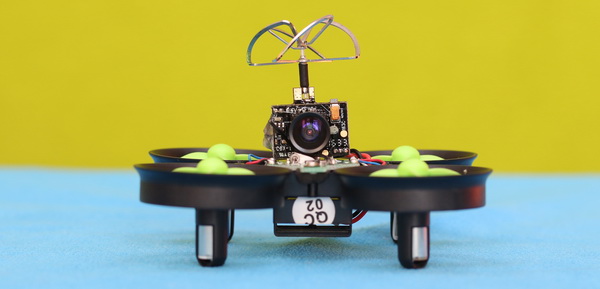
Eachine TX01 and TX02 review
Like my other Eachine cameras, these two FPV cams were also offered by the courtesy of Banggood in order to make an honest review. Thanks again for your continuous support.
As I previously mentioned, the TX01 and TX02 are very similar, even the box content is identical. Both came with a lens cap, pre-soldered power cable, cable adaptor (2-pin Pico blade male to micro-LOSI female), and instruction guide. The cameras are well protected by two pieces of foam during shipping. Unfortunately, the package does not include a “Y” (2 Way splitter) cable that allows you to power both aircraft and camera from the same battery easily.
The size of these two tiny FPV cameras is the same (19 x 7 x 13 mm – without antenna), the TX01 weighs about 4.5g, and the TX02 4.7g. The nickel-plated 4-lobe antenna is directly soldered on the top of the camera’s TX board.
Both cameras have the same shape and layout. A 7-segment LED display is located on the rear, and a single control button is located on top. By pressing the micro push-button you can change the CH number (1 – 8), and by long pressing can change the band (A, b, E, F, r). By pressing the button for about 10 seconds, it can be switched ON/OFF.
Although the blue LED display looks pretty good, I found it useless because I do not change FPV channels too often. Don’t mention that it adds extra weight and power consumption.
As I previously mentioned, the power cable is pre-soldered (frankly, I would have preferred a connector). To prevent detachment of the power cable, it is secured with some black glue.
Eachine TX01 & TX02 features and specs
- 3 in 1 design (camera, 5.8G TX, and antenna);
- One button control;
- Works with 1s Li-Po battery (3.3-5V input voltage);
- Non-volatile memory for storing CH and Band number;
- 7 segment status display;
- 4 lobe right-hand circular polarized 5.8G antenna;
- Output power: 25 mW on TX01 and 200 mW on TX02;
- 40CH 5.8G wireless video transmission (including race band);
- NTSC video format;
- Resolution: 600 TVL (720 x 480);
- Image sensor: 1/4″ CMOS;
- 120-degree viewing angle;
- Minimum illumination: 1 lux;
- Size: 20 x 13 x 6mm (according to the manufacturer’s specs);
- Weight: 4.48g (TX01) and 4.57g (TX02).
Eachine TX01 & TX02 Review – Test
To test the camera I used a 1cell 600 mAh battery from my Syma X5C and the Eachine LCD5802S FPV display. I powered the camera through the included power adapter cable.
By default, the VTX is set to channel 1 and band A. Changing the channel/band can be easily done and it is stored in non-volatile memory, so you don’t need to set it every time you connect the camera to the battery. The display permanently shows the channel number, band and TX status.
Unfortunately, the focus point of the camera cannot be adjusted (by rotating the lens), but don’t worry, it is set very well by the manufacturer.
The image quality is decent for such a tiny FPV camera. In my opinion, a bit better contrast would make the live-video feed even more enjoyable.
I got about 180 meters range with the Eachine TX01 and about 320 meters with the Eachine TX02 (both in open field). I think this is quite good and the Eachine TX01 will be just perfect for micro quads like the Eachine E010.
Using a 5V BEC (DC to DC step-down converter), you can adapt these FPV cameras to work even with 6s Li-POs.
Eachine TX02 RAW video was captured with miniDVR (on a foggy day).
Pricing, availability, and alternatives
For those who are interested in building their own micro FPV drone or just upgrading an existing one, the TX01 with 25 mW transmission power can be ordered from here and the TX02 with 200 mW from here.

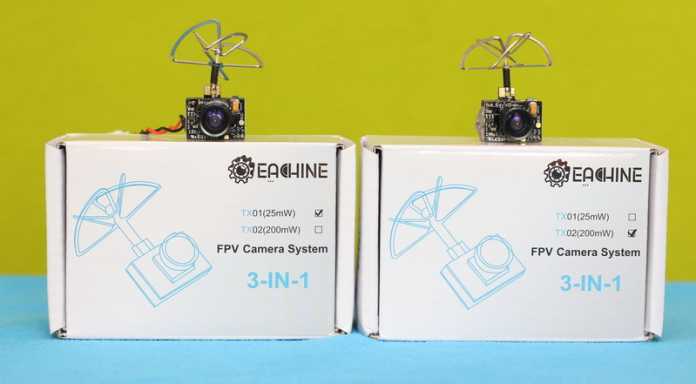
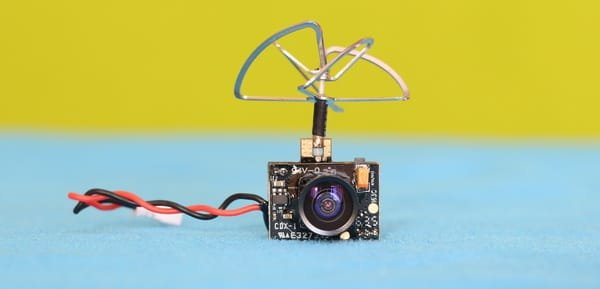

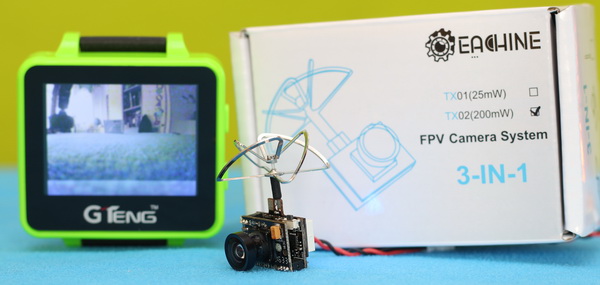
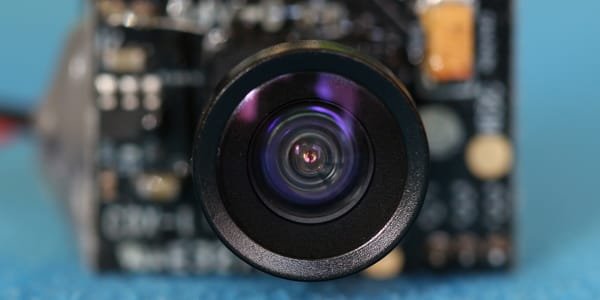
Is there built-in mic in tx02 pro?
Do you have any battery brands you could recommend for the TX01? This is my first FPV setup and I’m still learning.
I got one of these Eachine TX02 FPV AIO cameras, exactly what kind of battery do I need?
It works with 1s batteries
one question: what kind of receiver do you have to use for the TX02?
you can use almost any 5.8G analogue FPV receiver. Also 5.8G racing goggles and monitors
how to adjust “=” for on….tx02
Eachine just announced the TX03 AIO camera.
The Eachine TX03 comes with adjustable output power (25mW, 50mW and 200mW).
What a stupid thing, the TX02 is more expensive than the TX01, Why???
Anyway, I will order the Eachine TX01. I want to turn my Syma X5C into a FPV quad :D